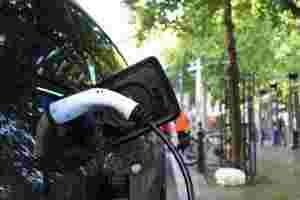This futuristic EV promises a mind-melting 1,000km range on a single charge
The 2021 Lucid Air shook up the EV market with its whopping 837km range, but now there’s a new player in town with an even higher number: the Norwegian company Fresco Motors .

Let’s start with the most impressive spec: the Fresco XL is slated to come with a single charge range of 1,000km . That’s enough to get you from Amsterdam to Paris — and back.
According to the company, this has been made possible thanks to the vehicle’s aerodynamic trims and extra-large battery pack. Hence the car’s name, I guess.
What exactly does an extra-large battery pack mean, you ask? We reached out to Fresco to find out and will update the article if we receive a response.
One thing the company did reveal though is the battery will be double stacked on the car’s dual electric motors (placed on each axle), facilitating the 1,000km range.
Don’t get fooled by the car’s minimalist exterior. It’s actually an eight-seater sedan, designed to perform as an all-weather, off-roader as well.
The dual motors function to provide grip and traction on icy roads, it features all-wheel drive (AWD), and can be transformed into a camper by pulling down the passenger seats.
Plus, you can hook it up to your house and use it as a backup energy storage unit in case of a power failure — how cool is that?
Interestingly, the company itself describes the Fresco XL not as a car, but as a pod. And, aesthetically, I can see why, especially when you compare it to something like this from Project Insight :
But, in a more real sense, the Fresco XL is still definitely a car.
In my mind, it isn’t trying to be pod-like, more following the design of futuristic spaceship-looking cars, like the Teorema and the Cadillac InnerSpace .
Whatever you think of the aesthetics, Fresco seems to have an impressive vehicle here — on paper at least. We’re still yet to see if the production-ready version will bring what’s promised to the table. Sometimes there’s a big gap between what EV-makers believe they can do, and what they actually can.
You can already pre-order it on the company’s website, and, yes, it comes with an impressive price tag as well: $114,330.
And if you’re hungry for some more information about the Fresco XL? Well, we’ll leave you with this reveal video:
Volvo owner Geely partners with China’s biggest search engine company on autonomous cars
Geely, the Chinese owner of Volvo, Lotus, and Polestar, is going to work with Chinese search giant Baidu to develop electric cars, which will feature connected and autonomous technologies.

According to reports , the two companies are forming a partnership, which will create a new sub-brand for the vehicles. They’ll be built on Geely’s electric platform and will be fitted with mapping and infotainment features developed by Baidu.
With that in mind, we can think of this as a Chinese version of Android Automotive, which as it happens, was featured for the first time in another Geely-made vehicle, the Polestar 2.
Like Google, Baidu doesn’t just develop web search technologies. Its subsidiaries have been developing autonomous vehicles for the past eight years.
AutoCar reports that some of these technologies will find their way on to the new Baidu and Geely-made cars.
The partnership is reportedly part of Baidu’s push to diversify its business away from relying on search advertising revenue, TechCrunch reports .
Due to the nature of Baidu being China-centric, I wouldn’t expect this sub-brand of vehicles to be made available outside the country — especially when Geely has brands like Polestar , Lynk & Co., and Volvo positioned to serve other markets.
Indeed, Geely and Baidu haven’t stated whether the partnership will extend beyond R&D of cars for its new sub-brand. So we’ll have to wait and see if features trickle across to Geely’s other brands or remain exclusive to its Baidu partnership.
SHIFT is brought to you by Polestar. It’s time to accelerate the shift to sustainable mobility. That is why Polestar combines electric driving with cutting-edge design and thrilling performance. Find out how .
EV charging software goes open source with Project EVerest
The development and expansion of the EV charging software ecosystem is a critical component to the mainstream adoption of electric vehicles. However, the industry has become complex and fragmented, with multiple isolated solutions and inconsistent technology standards. This slows and threatens the adoption of EVs.

In response, PIONIX has developed a project called EVerest , an open-source software stack designed to establish a common base layer for a unified EV charging ecosystem.
EVerest has gained some serious cred in the developer world, with its biggest support LF Energy (the Linux open-source foundation for the power systems sector). I spoke to the project’s brainchild, Dr. Marco Möller, managing director of PIONIX, to find out more.
What’s the problem with EV charging software?
The idea for EVerst came from Marco Möller’s previous startup, German commercial drone software firm MAVinci (Intel acquired the company in 2016). Möller shared:
After the initial founder team left Intel in 2020, they did consulting work with charging manufacturers and found that many engineers were involved in “me too” projects, effectively replicating the same code, even though 99% of the code was already engineered.
Shared open source implementations are vital to mitigate the differences in charging standards globally from CHAdeMo , commonly used by Japanese automakers, to China’s ChaoJi , and CCS , popular in Europe and the US.


Further, every car is slightly different, making it even more urgent to have an open-source solution for the chargers. An open tech stack means developers can focus on more exciting work and bring products to market faster.
The EVerest EV charging solution
Möller explained that the project had received interest from various players in the EV charging space, except for a few big proprietary players, noting:
The EVerest software platform runs on a lightweight Linux system inside the charging point . It manages communication around energy between different players:
Car (e.g., EN IEC 61851 , ISO 15118 )
Local energy generation & batteries (e.g. , Modbus , Sunspec )
Grid (including specific grid constraints)
Cloud backend / payment (e.g. OCPP 1.6)
The user (interface)
EVerest digitally abstracts the complexity of multiple standards and use cases. This means it can run on any device, from AC home chargers to public DC charging stations. This helps facilitate new features for local energy management such as local energy management, PV integration, and initiatives like wind and solar-powered EV stations and bi-directional charging.
What about the elephant in the machine: security?
There’s been a lot of research about the challenges of securing EV chargers , especially preventing hackers from using them for over or undercharging , committing identity fraud, or damaging the grid.
Vulnerabilities in open-source libraries have increasingly become an attack vector. The insertion of malicious code being inserted into packages in repositories (for example, npm and PyPI) is rising, and the recent Log4j zero-day exploits demonstrate the challenge of code maintenance in open source projects.
However, having a project under the auspices of The Linux Foundation is an advantage. It especially helps lend credibility increases the number of people working on the code. Möller noted:
The project is also liaising with the hacker enthusiast community to participate in hackathons over the summer months hopefully. As Marco asserts, “these people who break systems for fun.” The team is also raising venture capital, which will go into developing and improving the open-source codebase.
In short, EVerest welcomes the global community to contribute to this project. Visit the project on GitHub and subscribe to the EVerest general mailing list .